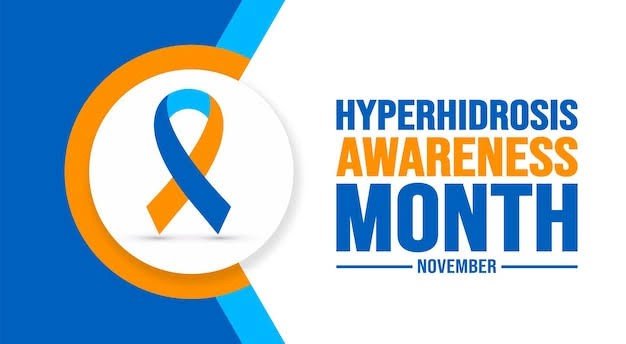Hyperhidrosis Awareness Month: Shedding Light on an Overlooked Condition
Every year, Hyperhidrosis Awareness Month shines a spotlight on a condition that affects millions worldwide yet remains widely misunderstood and underdiagnosed. For those living with hyperhidrosis, excessive sweating is not just a minor inconvenience—it’s a life-altering challenge that impacts physical comfort, emotional well-being, and daily activities.

This awareness month aims to educate the public, destigmatize the condition, and promote effective treatments that can help individuals regain confidence and control over their lives.
What Is Hyperhidrosis?
Hyperhidrosis is a medical condition characterized by excessive sweating beyond what is necessary to regulate body temperature. This sweating often occurs in specific areas such as the underarms, palms, soles, or face, but can also affect the entire body.
Types of Hyperhidrosis
- Primary Hyperhidrosis:
The most common type, caused by overactive sweat glands without any underlying medical reason.
Typically affects specific areas like the underarms (axillary), hands (palmar), or feet (plantar). - Secondary Hyperhidrosis:
Caused by underlying conditions such as diabetes, menopause, thyroid issues, or certain medications.
Often affects larger areas of the body.
Prevalence
It’s estimated that 5% of the global population suffers from hyperhidrosis. Despite its prevalence, many go undiagnosed due to embarrassment or lack of awareness.
The Impact of Hyperhidrosis
While sweating is natural and healthy, excessive sweating can cause significant physical, emotional, and social challenges.
- Physical Effects:
Constant wetness leads to skin irritation, rashes, and infections.
Frequent changes of clothing and reliance on antiperspirants can be inconvenient and costly. - Emotional Effects:
People with hyperhidrosis often experience low self-esteem and anxiety.
Fear of public embarrassment can lead to avoidance of social or professional situations. - Social and Professional Challenges:
Shaking hands, using touchscreens, or even holding a pen can become stressful.
Visible sweat stains can hinder confidence during presentations or interviews.
Raising Awareness During Hyperhidrosis Awareness Month
The goal of this month is to break the silence around hyperhidrosis by fostering understanding, compassion, and awareness about the condition and its treatment options.
Key Objectives:
- Educating the Public:
Dispelling myths about excessive sweating (it’s not caused by poor hygiene).
Highlighting the medical nature of the condition. - Encouraging Early Diagnosis:
Many people suffer in silence without realizing effective treatments are available. - Promoting Treatment Options:
Advancements in hyperhidrosis management mean that excessive sweating is no longer a life sentence.
Effective Treatment Options for Hyperhidrosis
Hyperhidrosis can be effectively managed with a range of treatments, depending on the severity and area affected:
- Clinical-Grade Antiperspirants
Contain aluminum chloride to block sweat glands temporarily.
Ideal for mild cases of hyperhidrosis. - Botox Injections
FDA-approved for treating excessive underarm sweating.
Blocks the chemical signals that activate sweat glands. - Oral Medications
Anticholinergics reduce sweating by blocking nerve signals to sweat glands. - MiraDry
A non-invasive treatment that permanently eliminates sweat and odor glands using microwave energy.
Provides long-lasting results with minimal downtime. - Iontophoresis
A device that uses electrical currents to reduce sweating in hands and feet. - Surgery (ETS)
Reserved for severe cases, this procedure severs nerves that stimulate sweat glands.
Tips for Living with Hyperhidrosis
While treatment is essential, there are lifestyle changes and coping strategies that can help manage hyperhidrosis:
- Wear Breathable Fabrics: Choose cotton or moisture-wicking materials to stay comfortable.
- Use Sweat-Absorbing Pads: Place them under clothing to reduce visible sweat stains.
- Stay Hydrated: Drinking water helps regulate body temperature naturally.
- Seek Support: Joining hyperhidrosis support groups can reduce feelings of isolation.
Breaking the Stigma Around Excessive Sweating
One of the biggest challenges for individuals with hyperhidrosis is the stigma surrounding the condition. Many people falsely associate excessive sweating with poor hygiene or nervousness, leading to shame and social isolation.
This Hyperhidrosis Awareness Month, let’s work together to:
- Educate others about the medical nature of the condition.
- Offer support to those affected, reminding them they’re not alone.
- Advocate for accessible treatments and workplace accommodations.
Why Hyperhidrosis Awareness Matters
Raising awareness about hyperhidrosis is crucial not only to reduce stigma but also to empower those living with the condition. By fostering understanding and promoting effective solutions, we can help individuals with hyperhidrosis reclaim their confidence and improve their quality of life.
Anew Clinic: Helping You Manage Hyperhidrosis
At Anew Cosmetic Clinic, we understand how debilitating hyperhidrosis can be. That’s why we offer advanced treatments like the upgraded MiraDry, Botox, and more to help you live a sweat-free life.
This Hyperhidrosis Awareness Month, take the first step toward a confident, comfortable future.
Contact us today to schedule a consultation and explore personalized solutions for hyperhidrosis management. Together, we can help you embrace a life without limits!


